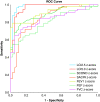Multiple-Breath Washout Outcome Measures in Adults with Bronchiectasis
- PMID: 35451922
- PMCID: PMC9447383
- DOI: 10.1513/AnnalsATS.202006-584OC
Multiple-Breath Washout Outcome Measures in Adults with Bronchiectasis
Abstract
Rationale: Lung clearance index (LCI) has good intravisit repeatability with better sensitivity in detecting lung disease on computed tomography scan compared with forced expiratory volume in 1 second (FEV1) in adults with bronchiectasis. Alternative multiple-breath washout parameters have not been systematically studied in bronchiectasis. Objectives: To determine the validity, repeatability, sensitivity, specificity, and feasibility of standard LCI (LCI2.5), shortened LCI (LCI5.0), ventilation heterogeneity arising within proximal conducting airways (ScondVT), and ventilation heterogeneity arising within the acinar airways (SacinVT) in a cross-sectional observational cohort of adults with bronchiectasis. Methods: Cross-sectional multiple-breath nitrogen washout data (Exhalyzer D; Eco Medics AG) from 132 patients with bronchiectasis across five United Kingdom centers (BronchUK Clinimetrics study) and 88 healthy control subjects were analyzed. Results: Within-test repeatability (mean coefficient of variation) was <5% for both LCI2.5 and LCI5.0 in patients with bronchiectasis, and there was no difference in mean coefficient of variation for LCI2.5 and LCI5.0 in patients with bronchiectasis compared with healthy volunteers. Moderate-strength correlations were seen between FEV1 and LCI2.5 (r = -0.54), LCI5.0 (r = -0.53), ScondVT (r = -0.35), and SacinVT (r = -0.38) z-scores. The proportion of subjects with abnormal multiple-breath washout (z-score > 2) but in normal FEV1 (z-score < -2) was 42% (LCI2.5) and 36% (LCI5.0). Overall results from the receiver operating characteristic curve analysis indicated that LCI2.5 had the greatest combined sensitivity and specificity to discriminate between bronchiectasis and control subjects, followed by LCI5.0, FEV1, and ScondVT z-scores. There was a 57% time saving with LCI5.0. Conclusions: LCI2.5 and LCI5.0 had good within-test repeatability and superior sensitivity compared with spirometry measures in differentiating between health and bronchiectasis disease. LCI5.0 is quicker and more feasible than LCI2.5. Clinical trial registered with www.clinicaltrials.gov (NCT02468271).
Keywords: bronchiectasis; lung function; multiple breath washout.
Figures




References
-
- O’Neill K, O’Donnell AE, Bradley JM. Airway clearance, mucoactive therapies and pulmonary rehabilitation in bronchiectasis. Respirology . 2019;24:227–237. - PubMed
-
- Bilton D, Daviskas E, Anderson SD, Kolbe J, King G, Stirling RG, et al. B301 Investigators Phase 3 randomized study of the efficacy and safety of inhaled dry powder mannitol for the symptomatic treatment of non-cystic fibrosis bronchiectasis. Chest . 2013;144:215–225. - PubMed
-
- Rowan SA, Bradley JM, Bradbury I, Lawson J, Lynch T, Gustafsson P, et al. Lung clearance index is a repeatable and sensitive indicator of radiological changes in bronchiectasis. Am J Respir Crit Care Med . 2014;189:586–592. - PubMed
-
- Grillo L, Irving S, Hansell DM, Nair A, Annan B, Ward S, et al. The reproducibility and responsiveness of the lung clearance index in bronchiectasis. Eur Respir J . 2015;46:1645–1653. - PubMed
Publication types
MeSH terms
Associated data
Grants and funding
LinkOut - more resources
Full Text Sources
Medical

